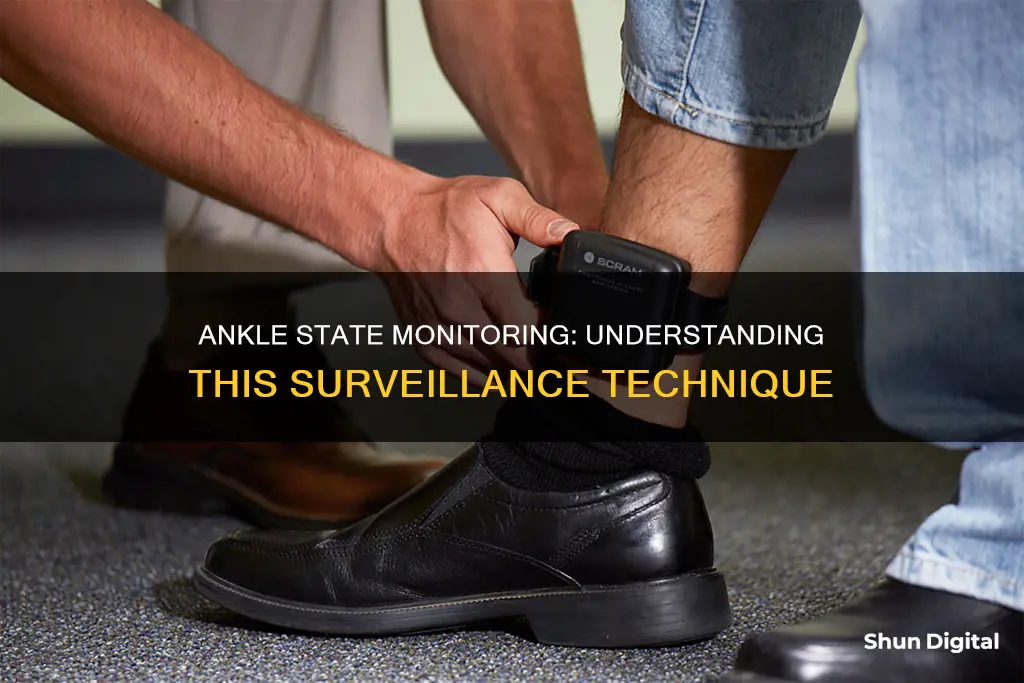
Ankle monitoring, also known as electronic monitoring, is a form of surveillance that uses an electronic device fitted to an individual's ankle to monitor their movements and activities. It is often used as an alternative to imprisonment, allowing people to live in their homes and maintain family connections while being tracked by law enforcement. This method of monitoring has become increasingly popular due to technological advancements and its potential to reduce prison populations and costs. However, there are also concerns about the effectiveness of ankle monitoring in reducing recidivism and its potential to infringe on civil liberties and privacy.
| Characteristics | Values |
|---|---|
| Purpose | To monitor, track and constrain an individual's movements outside of a prison, jail or detention center |
| Users | Defendants awaiting trial, convicted offenders on parole or probation, immigrants, and those on bail |
| Technology | GPS, RF, biometric security systems, automated check-in centers |
| Cost | $5 to $25 per day, $300 upfront, $50 installation fee |
| Payment | Paid by the wearer, or by the state or county |
| Effectiveness | Reduces recidivism, but can cause technical failures and false alarms |
| Advantages | More cost-effective, allows family life, averts victimization, eases prison overcrowding, and is less harsh |
| Disadvantages | Severing community ties, frequent technical failures, loss of employment, worsens racial disparities, invades privacy, causes health issues, and user fees |
What You'll Learn

Who pays for ankle monitors?
Ankle monitors are used to track the movements and activities of defendants awaiting trial and convicted offenders currently on parole or probation. They are also used to monitor sobriety. In most states, the individuals wearing ankle monitors are required to pay daily, weekly, or monthly fees, which can range from $5 to $35 per day. In some states, failure to pay can result in extended supervision, additional fees, or even jail time.
The cost of ankle monitors can be a significant financial burden, and in some cases, individuals have been made homeless by the expense. While some counties cover the total cost of the technology, in other cases, private companies provide the devices and pass the cost on to the wearers. This has raised concerns about the lack of public oversight in the decision-making process regarding fees and the potential for profit-driven decisions that may impact people's freedoms.
The fees for ankle monitors can vary depending on the state and the offence. In some states, the fees are authorised as a condition of pretrial release or post-sentencing supervision, while in others, the fees are imposed without specifying an amount, leaving it up to the EM provider to set the fee. Only a few states consider the individual's ability to pay when determining the cost.
The financial implications of ankle monitors go beyond the device itself. Additional costs may include a landline phone, which is required in many states, as well as the cost of replacing or repairing any damaged or missing parts. Furthermore, the devices can cause skin irritation and may limit access to certain medical procedures.
While ankle monitors are intended to provide an alternative to incarceration, the high costs associated with them can create a form of financial incarceration, impacting individuals' abilities to pay for basic needs such as rent and meals. This raises questions about the effectiveness of ankle monitors in supporting rehabilitation and reintegration into society.
Curved Monitors: Immersive Viewing for Enhanced Productivity
You may want to see also

Ankle monitors and mental health
Ankle monitors are used to track the movements and activities of defendants awaiting trial and convicted offenders on parole or probation. They are also used to monitor sobriety, with Secure Continuous Remote Alcohol Monitors (SCRAM) able to detect alcohol in a person's sweat.
The use of ankle monitors has been criticised for causing mental health issues, including anxiety and depression, as well as exacerbating existing mental health issues. The stigma and social isolation of wearing an ankle monitor can negatively impact the mental health of the wearer, and the restrictions on movement can cause stress and inconvenience. In addition, the financial burden of paying for an ankle monitor can lead to debt and unemployment, further contributing to mental health issues.
For some, the alternative to an ankle monitor is incarceration, which can also take a toll on mental health. However, ankle monitors are not always an effective alternative to incarceration as they can be restrictive and invasive. Wearers of ankle monitors may be subject to curfews and excluded areas, limiting their movements and impacting their daily lives. The devices can also be uncomfortable and cause skin irritations.
The high cost of ankle monitors can be a significant burden, with daily fees ranging from $5 to $40, and setup fees of up to $200. In some cases, the wearer is responsible for paying these fees, which can lead to financial difficulties and even homelessness. This financial strain can contribute to mental health issues and create a cycle of poverty.
In addition, ankle monitors can interfere with employment opportunities, as some employers may be hesitant to hire individuals with ankle monitors. This can further contribute to financial instability and impact an individual's ability to pay for the monitor.
While ankle monitors can provide an alternative to incarceration, it is important to consider the potential mental health implications and ensure that the benefits outweigh the costs.
Buying Studio Monitors: What You Need to Know
You may want to see also

Ankle monitor technology
Ankle monitors are usually fitted above the ankle and use GPS and RF technology to track an individual's location in real time. GPS, or Global Positioning System, works similarly to a car navigation system, while RF, or radio frequency, technology monitors the presence or absence of the wearer within a specific location. This type of monitoring is particularly useful for individuals under house arrest or with a curfew, as it allows authorities to ensure compliance with the terms of their release or sentence.
In addition to tracking location, ankle monitors can also be used to detect alcohol consumption. The Secure Continuous Remote Alcohol Monitor (SCRAM) bracelet, for example, can detect alcohol in a person's sweat and alert authorities if the person violates the terms of their release or probation. Ankle monitors are typically waterproof and lightweight, but they are not permitted through airport security.
While ankle monitors are presented as a more humane alternative to incarceration, there are concerns about the impact on wearers' liberties and the financial burden they impose. Wearers are often required to pay for the device themselves, with fees ranging from $5 to $35 per day. Additionally, the devices can be uncomfortable and cause skin irritations. There are also concerns about the lack of privacy and the potential for false alarms, which can lead to individuals being sent back to jail for minor technical violations.
Despite the concerns, ankle monitor technology has been shown to be effective in certain cases. For example, a 2001 study of 5,000 medium- and high-risk offenders in Florida found a 31% decrease in the recidivism rate over six years for those under electronic supervision. Proponents of ankle monitor technology argue that it is more cost-effective than incarceration, allows individuals to maintain family connections, and can help reduce prison overcrowding.
Astro Headphones and Asus Monitors: Easy Setup Guide
You may want to see also

Ankle monitors and the law
Ankle monitors are a form of surveillance that uses an electronic device affixed to an individual. They are commonly referred to as ankle bracelets, ankle shackles, or tethers and are worn around the lower leg. The use of ankle monitors has become increasingly popular in recent years, with the number of people using them more than doubling between 2005 and 2015. They are used to track the movements and activities of individuals who are awaiting trial, on probation or parole, or facing immigration proceedings.
Ankle monitors typically use GPS tracking systems to record the location of their wearers. This allows authorities to limit how long a person can stay outside and where they can go. In addition to GPS, radio frequency (RF) technology can be used for short-range monitoring. RF devices monitor the presence or absence of the wearer from an exact location and are primarily used for those under house arrest or curfew.
Who uses them?
The use of ankle monitors is not limited to a specific group of people. However, they are commonly used for individuals who are awaiting trial, on probation or parole, or facing immigration proceedings. For example, in 2018, the US government released detainees from immigration detention centres and required them to wear electronic ankle monitors. In addition, ankle monitors can be used for those under a curfew given under the Terrorism Prevention and Investigation Measures Act.
The benefits
Proponents of ankle monitors argue that they are more humane than incarceration, allowing individuals to live at home and move freely within their homes. They also argue that ankle monitors save money for cash-strapped states and benefit offenders by allowing them to work and pay taxes. In addition, ankle monitors can be used to incapacitate violent criminals and reduce recidivism, though studies on their effectiveness in reducing repeat offences have produced mixed results.
The drawbacks
Critics of ankle monitors argue that they fail to reduce recidivism and undermine rehabilitation by severing a person's ties to the community. They also result in frequent technical failures and false alarms, creating an administrative burden for law enforcement. In addition, ankle monitors can make it difficult for individuals to hold a job and earn enough income, especially when coupled with high user fees. This can lead to spiralling debt, particularly for those from impoverished and socially marginalised communities.
The bottom line
While ankle monitors can provide an alternative to incarceration, it is important to consider their potential drawbacks and impact on individuals' lives. Studies have shown that they can fail to meet their stated goals of ensuring court appearances, protecting public safety, and advancing rehabilitation. As such, it is crucial to evaluate their use on a case-by-case basis and explore less restrictive alternatives.
Measuring Monitor Response Time: A Quick Guide
You may want to see also

Ankle monitors and racial disparities
Ankle monitors are used to track the movements and activities of defendants awaiting trial and convicted offenders currently on parole or probation. They are often used as an alternative to prison sentences, allowing people to live in their homes and maintain their jobs. This form of monitoring has become increasingly popular due to technological advancements and its cost-effectiveness. However, the cost of renting and maintaining these devices is often borne by the wearers, which can lead to financial hardship and, in some cases, homelessness.
While ankle monitors may offer an alternative to incarceration, they have been criticised as a form of "digital shackles" that restrict the liberty of the wearer. This is particularly true for people from impoverished and socially marginalised communities, who are overrepresented among those subject to electronic monitoring. The rules and restrictions associated with ankle monitors can be stringent and any violations, even minor ones, can result in a return to prison.
Beyond the financial burden, ankle monitors introduce new ways for the wearer to end up back in prison. For example, a bus delay or a power outage that prevents the device from charging can be considered a violation. This creates a constant risk of re-incarceration that can affect the wearer's ability to maintain employment and housing.
In the United States, racial disparities in the criminal justice system are well-documented, with people of colour being overrepresented at every stage, from arrest to sentencing. Given that ankle monitors are used as an alternative to incarceration, it is likely that racial disparities exist in their use as well. However, there is a lack of specific research or data on the racial breakdown of ankle monitor usage.
While there is no clear evidence of racial disparities in ankle monitor usage, it is important to consider the broader context of racial inequality in the criminal justice system. The overrepresentation of people of colour in the system suggests that they may also be disproportionately subject to electronic monitoring. Additionally, the financial burden of renting and maintaining ankle monitors may disproportionately impact communities of colour, who are more likely to experience poverty and financial instability.
In conclusion, while there is no definitive evidence of racial disparities in ankle monitor usage, it is important to consider the broader context of racial inequality in the criminal justice system. The financial and liberty constraints imposed by ankle monitors may disproportionately impact communities of colour, contributing to existing inequalities and requiring further investigation.
Am I Being Watched? Signs of Surveillance
You may want to see also
Frequently asked questions
Ankle monitoring is a form of surveillance that uses an electronic device affixed to a person's lower leg to track their movements and activities.
Ankle monitoring is used on defendants awaiting trial and convicted offenders currently on parole or probation.
Ankle monitors use GPS and RF technology to track someone in real-time and report this information to the authorities.
Ankle monitoring is a way to allow people to live in their homes rather than in jail. It is also a cheaper alternative to incarceration and can help deter people from reoffending.







